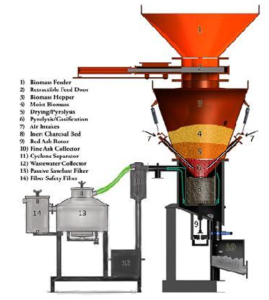How is biomass energy generated?
Biomass fuel has been around for thousands of years as a major source of energy prior to the discovery of fossil fuels like coal and petroleum. But question may probably come to your mind how does biomass work to generate energy from organic matters? I have in this article, therefore, tried to explain how energy is produced from biomass, a renewable and sustainable source of energy. However, before we go into the details of how is biomass energy generated let’s first look into – what is biomass?
What is biomass?
Biomass is organic material of biological origin which is a renewable and sustainable source of energy. It is a key building block of bio-fuels, which can be specially grown for electricity production or to produce heat, as an alternative to fossil fuels. The key difference between biomass and fossil fuels is the difference between the times they take to replenish the sources of each. Examples of biomass materials include forest residues (branches, dead trees, and tree stamps), agricultural crops or wastes, wood chips, yard clippings, manure, animal and human wastes and much more. Biomass, besides using in solid form, can be converted into both liquid and gaseous form through a wide range of conversion and refining processes.
Now that we know what is biomass let’s look into – how does biomass work for energy generation?
You may also like to read the related post: Advantages and Disadvantages of Biomass Energy
How does biomass work to store solar energy?
Biomass gets its energy from the sun. Biomass store energy from the sunlight in the form of chemical energy by the process of Photosynthesis. To describe how does biomass work to convert sunlight into chemical energy the process of Photosynthesis needs to be explained.
Photosynthesis is a process used by plants and other organisms to convert radiant energy from the Sun, into chemical energy in the form of glucose (or sugar) that can be later released to fuel the organisms’ activities. Through the process of photosynthesis, chlorophyll, which is a green pigment found in almost all plants, captures the sun’s energy by converting carbon dioxide from the air and ground water into carbohydrates, a complex compound composed of carbon, hydrogen, and oxygen. When burnt, these carbohydrates turn back into carbon dioxide and water and release the energy they captured from the sun.
Thus, biomass functions as a natural storage system of solar energy like batteries. As long as biomass is produced with minimal long-term effect on the resources including land’s capacity to re-grow biomass plants, this natural storage system would continue to be the source of energy for an indefinite period, which is one of the main advantages of biomass fuel. Worldwide photosynthetic activity on plants is estimated to store more than 15 times, as much energy as is annually consumed by all the nations in the world!
How does biomass work to produce electricity?
Now let us see, how does biomass generate power? The most common method to produce heat and electricity from biomass has been to burn it in a boiler. The most common types of boilers are hot water boilers and steam boilers. Burning biomass in conventional boilers has many ecological advantages over burning fossil fuels. Wood chips, residues and other types of biomass are used in the boilers, in the same way as fossil fuels like coal, natural gas and oil.
Advancement in recent years has shown that a process called ‘Gasification’ is more efficient and cleaner way to produce combustible gases from biomass, which can be used in boilers for power generation. Gasification process reduces emissions of various particulates from biomass combustion.
What is Gasification of biomass?
Now let’s see how does biomass work to produce combustible gas through the process of Gasification.
Gasification is a process that converts organic materials into carbon monoxide, hydrogen and carbon dioxide. In biomass gasification process, biomass fuel is burnt in a device called ‘Gasifier’, which involves burning of biomass with a controlled supply of oxygen to give a clean combustible gas. A biomass gasifier takes dry biomass, such as agriculture waste, and burns it with restricted supply of oxygen and at high temperature (>700 °C), which results in breaking down of matters and release of volatile gas called ‘Syngas’ (also called Synthesis gas). The Syngas produced through gasification is predominately carbon monoxide, hydrogen, and carbon dioxide and can be used in place of natural gas or converted with catalysts to ethanol.
The gasification process also turns wet biomass, such as food waste and human and animal waste, into methane by a machine called ‘Anaerobic Digester’. The gas produced by the process of gasification is cleaned to make it suitable for use in boilers, engines and turbines for thermal application or for power generation.
By using the above gas it is also possible to operate a diesel engine on dual fuel mode. The gas is fed into a modified diesel engine which runs on a mixture of gas and diesel, resulting in a saving up to 80% of the diesel consumption. The engine is connected to a generator that produces electricity. The waste heat from the engine can be used for drying, heating or boiling water, or for running air-conditioning or cold storage plants.
One of the main advantages of biomass gasification is that it has a continuing role in providing access to electricity. An increasing number of companies in Asia and elsewhere are producing ‘gasifiers’ for this purpose. At the existing cost of biomass fuel and normal financing conditions as applied to renewable energy power projects, the cost of energy generation from biomass gasification based power plants using diesel engines running in a dual fuel mode is always lower than that from normal diesel engines running on pure diesel oil. In an industrial plant where an existing diesel set is re-modeled for use with a biomass gasification plant the payback period in a typical case, can be as low as 1 to 3 years.
You might also like to read this related post: 11 Major Pros and Cons of biofuels you need to know
Conclusion
From the discussion above on how does biomass work it is clear that Biomass is a great way to create energy from the organic matters of various renewable energy sources such as plants, woods and animal wastes. Biomass can be directly burned to produce heat and electricity or can be converted to bio-fuels like bio-ethanol and bio-diesel through various processes. Biomass has emerged as one of the major alternatives sources of power generation and for providing heating solution on a domestic and commercial scale.


